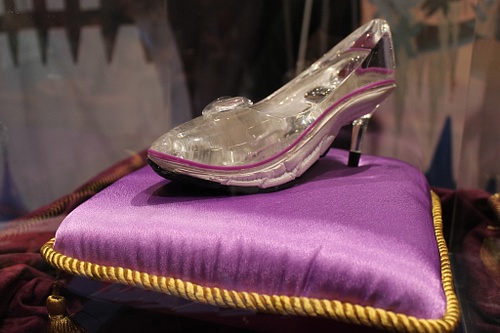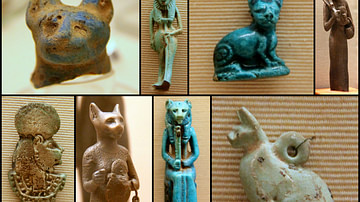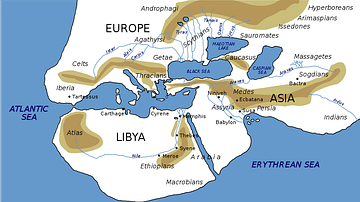The story of Cinderella is one of the most popular in the world. In the west, it has enjoyed a continuous following since its revision and publication by Charles Perrault in 1697 CE but the tale of the young heroine, unjustly forced into servitude, who becomes elevated to royalty was told for centuries before in China during the Tang Dynasty (618-907 CE) in the story of Yeh Shen. In this story the evil step-mother and step-sister kill the animal friends of Yeh Shen but in the end are destroyed and the girl wins the hand of the king.
The story was re-worked in the 17th century CE in Italy, prior to Perrault's version, by the poet Giambattista Basile (1566-1632 CE). The posthumous publication of Basile's now famous children's book, Il Pentamerone, in 1634 CE included the story La Gatta Cenerentola (The Cat Cinderella) which is recognized as the first European appearance of the story in print although, like Basile's other tales, it was already known in Italy. The story was afterwards re-worked and published in other forms in Germany, Russia, and other countries. Scholar Particia Monaghan, writing on the Cinderella tale, notes:
Cinderella's thousand-year global circulation makes it the world's best-known fairytale, but no one can really say where it began or when Cinderella's magic slippers brought her to Europe. (186)
A number of modern-day authors, however, in print and online, claim that the story originated in ancient Egypt and provide a version which they attribute to the Greek historian Strabo (65 BCE-23 CE). All of these writers repeat essentially the same version of the tale - which is nothing like Strabo's - but is given authenticity by their citation of him as their source. These writers even go so far as to cite "facts" from ancient history which support their claims that the folk tale is based on actual events and some cite Herodotus or other ancient sources to give their claims more weight.
In reality, the tale they continue to present as the "Egyptian Cinderella" has no Egyptian origin and, in its present version, appears nowhere in ancient literature. Strabo's version of the so-called "Egyptian Cinderella" has almost none of the elements of the popular modern-day version.
The proliferation of sites and articles now claiming the story is an Egyptian work not only spreads misinformation but is a disservice to the actual author of the story which most likely inspires their claims: Mrs. Olive Beaupre Miller (1883-1968 CE) of Aurora, Illinois, USA. Miller brilliantly re-imagined Strabo's account, entwining it with Perrault's tale, to create an ancient Egyptian Cinderella and later writers, having no knowledge of Miller or her work, now present the story as a genuine ancient tale; it is actually less than 100 years old.
Strabo's Account & Other Sources
Strabo tells the story in his Geography, Book XVII.33. Strabo's account is actually quite brief. He relates how, while traveling through Egypt, he heard a story concerning a courtesan named Rhodopis for whom the third pyramid at Giza was built. He writes:
They tell the fabulous story that, when she was bathing, an eagle snatched one of her sandals from her maid and carried it to Memphis; and while the king was administering justice in the open air, the eagle, when it arrived above his head, flung the sandal into his lap; and the king, stirred both by the beautiful shape of the sandal and by the strangeness of the occurrence, sent men in all directions into the country in quest of the woman who wore the sandal; and when she was found in the city of Naucratis, she was brought up to Memphis [and] became the wife of the king.
Strabo's account, unlike the present version attributed to him, includes no evil "step-sisters" who persecute the maid, no master, and no festival; the only motif of the Cinderella tale is the "slipper" used to find the woman who will be the king's wife. The bird is also clearly identified as an eagle which was not known in Egypt for most of its history and appears in no iconography until the Ptolemaic Dynasty (323-30 BCE) and, even then, would not have been the bird of choice in an ancient Egyptian story.
Strabo identifies the woman as Doricha who was the lover of Sappho's brother Charaxus and corrects Herodotus who refers to her as Rhodopis in his Histories II:134. Doricha may have been the birth name of Rhodopis (which means "rosy-cheeked" and was probably an epithet) or they could have been two different women. Herodotus identifies Rhodopis as a Thracian who was sold into slavery in Egypt and worked as a highly paid courtesan in the city of Naucratis, owned by the same master who held the writer Aesop as a slave. The later writer Athenaeus of Naucratis (3rd century CE) claims that Rhodopis and Doricha were two different women: Rhodopis was a courtesan of great beauty while Doricha was a pious woman who made regular offerings to the gods. Neither Herodotus, pre-Strabo, nor Athenaeus, later, mention the story of the bird and the sandals. The historian Aelian (175-235 CE) repeats Strabo's story with some alteration in his Various Histories XIII:33, On the Fortune of Rhodopis, a Courtesan:
The Egyptians' relations affirm that Rhodopis was a most beautiful Courtisan ; and that on a time as she was bathing her self, Fortune, who loveth to do extravagant and unexpected things, gave her a reward : sutable, not to her mind, but her beauty. For whilest she was washing, and her Maids look'd to her clothes, an Eagle stooping down, snatched up one of her Shoes, and carried it away to Memphis, where Psammetichus was sitting in Judgement, and let the Shoe fall into his lap. Psammetichus, wondring at the shape of the Shoe, and neatness of the work, and the action of the Bird, sent throughout Ægypt to find out the Woman to whom the shoe belonged ; and having found her out, married her.
In these ancient accounts, Rhodopis was a beautiful and high-priced hetaira, a courtesan of many skills, and would not have been considered a suitable role model for Olive Beaupre Miller in writing children's literature. Miller, therefore, changed the courtesan to a young maiden.
Miller's Version
Miller wrote her story of Rhodopis as part of her Bookhouse for Children publishing house and, although it does not have all the elements of the faux-ancient tale presently so popular, seems to be the most immediate source. Olive Beaupre Miller was a writer who abandoned her literary pursuits when she feared they were distracting her from motherhood. She dedicated herself to her daughter, Virginia, but was still interested in writing and literature. When she could not find stories suitable to read to her daughter, she decided to create her own. Joan Evanich, of the Winnetka Historical Society, elaborates:
Olive Beaupre Miller was constantly seeking appropriate children's literature to read to her daughter. She considered stories proper if they fit three criteria: They had to be well written, make a positive ethical statement, and be graded to fit the developmental age of the child. If she was unable to find a story or poem that met all three requirements, she wrote one herself. (1)
She and her husband started a publication house known as Bookhouse for Children which published the kinds of stories Miller thought appropriate for young minds. Miller would include poetry by Emily Dickinson, Longfellow, and prose by other writers but, when she could not find a story which fit just right for a certain volume, she created one she felt suitable. She wrote the story Rhodopis (The First Cinderella Story) for the Bookhouse volume Through Fairy Halls published in 1920 CE in order to provide her audience with a charming tale she knew would be popular.
On the first page of the story, Miller writes a disclaimer stating that the tale of Queen Nitocris (whom she identifies as Rhodopis) is the oldest of the Cinderella stories and "was told to little children several thousand years before Christ" (262). Nitocris, best known from the story told of her by Herodotus (Histories II.100) and her mention by Manetho (3rd century BCE), has nothing to do with the courtesan Rhodopis. The story Herodotus tells of Nitocris has to do with her avenging herself for her brother's murder by inviting his killers to a banquet and then drowning them. It is unclear why Miller would have claimed these two women were the same person but, that aside, there is no evidence the story she then tells was known thousands of years ago nor that it "is to this day a favorite fairy tale in Egypt" (262). The story is, in fact, Miller's own creation.
Miller brilliantly recreates the brief account given by Strabo as a tale of a beautiful Egyptian maiden whose gilded sandal is taken by an eagle while she is bathing in the Nile. The action of the story then switches to the king on his throne dispensing justice and showing mercy to a farmer who could not pay his taxes. The king is despondent because he has no wife and no family when, suddenly, the eagle drops the sandal into his lap.
Taking this as a sign from the gods, he mounts a nationwide search for the maiden whose foot will fit the sandal but cannot find her. The king is in despair because he believes he has tried the sandal on the foot of every available woman. At this point the farmer whom he spared earlier returns and tells the king's chief scribe that one lovely maiden has been overlooked. He then tells them where Rhodopis bathes in the morning and they go there to find her. Rhodopis' foot fits the sandal perfectly, of course, and she produces its mate. She becomes the queen of Egypt and the story ends happily.
As with all of Miller's work, the story is well told with perfect pacing; but it is not an ancient Egyptian tale. At some point between its publication in 1920 CE and the present, however, someone revised it so it became the version one finds in publications on the internet and elsewhere.
The Modern "Egyptian Cinderella"
The version of this tale popularly known as the "Egyptian Cinderella" transforms many of Strabo's, Aelian's, and Miller's elements into a much more elaborate tale. Here, Rhodopis is a poor slave girl, kidnapped from Greece, who is living in Egypt in the company of other slave-women who treat her poorly (the "step-sisters" of the Cinderella tale). She is kind-hearted and long-suffering, communes with animals, and works for a gentle master whose great pleasure is to nap under a favorite tree while his slaves take care of his household.
Rhodopis is quite graceful and one day her master sees her dancing while doing her work and is impressed by how she seems to almost glide over the ground. He has a pair of beautifully ornamented slippers made which he gives to her. Soon after, when word comes that the pharaoh Amasis is holding a grand festival, Rhodopis is excited to attend and imagines herself dancing in her lovely shoes. The other servant girls have never liked her, however, and are now even more jealous that she has been shown such favor by the master. They give her even more work to do and tell her that she cannot attend the festival until all is completed. Rhodopis is hard at work when she sees the master's barge sail away for the festivities with the other girls on board.
She sings a sad song which upsets a nearby hippopotamus who splashes into the Nile and wets her slippers. Rhodopis sets these on a nearby rock to dry when a great eagle (sometimes given as a hawk or falcon) swoops down and takes one up in his claws. The girl is distraught over the loss but puts the slipper she has left in her dress for safekeeping and returns to her work.
At the festival, Amasis is sitting on his throne, bored and despondent over his lack of a wife, when the bird drops the slipper in his lap. He recognizes this is a sign from the god Horus and whichever maiden's foot fits the slipper will become his queen. He has every single woman at the festival try on the slipper but none fit.
Amasis, like the prince in the Cinderella tale, then goes throughout his kingdom searching for the girl whose foot will fit the slipper. He finally finds Rhodopis who not only fits the slipper but draws its mate out of her dress. The story ends with Rhodopis, soon to be queen, happily being praised by the king as the servant girls who were so cruel to her must return to their work.
This version takes Miller's account and adds the details of the plot one finds in the Cinderella story as it is best known: a poor girl unjustly treated is saved by magic and elevated to queen while those who abused her suffer. This is clearly a story developed from the Cinderella tale of Perrault and the "ancient Egyptian Cinderella" of Miller, not from Strabo's account. In claiming that their source for the story is Strabo, writers must convincingly deal with four main objections:
- Strabo's account, as noted, does not contain most of the elements these writers include.
- There is no known Egyptian version of the story and no precedent for this kind of story in Egyptian literature. Goddesses are frequently featured as main characters in legends and tales, not women.
- No other writer makes mention of this particular story even though many reference a woman of great beauty named Rhodopis and reference Strabo.
- The story of a Greek slave girl who becomes a queen of Egypt would not have been well-received by the Egyptian culture throughout most of its history.
Repetition as History
Strabo was writing in the 1st century CE during the Roman Period of Egypt's history which followed the Ptolemaic Dynasty. It is possible that some story about a young slave-girl from Greece, who married an Egyptian king through divine intervention, was told during the Ptolemaic Period and this was repeated to Strabo. If so, however, there is no evidence of it. Strabo, Herodotus, and others all mention Rhodopris as linked to the brother of the poetess Sappho, tell the story of how he spent too much money to buy her freedom and was chastised by his sister, and how she was a woman of great beauty; but nothing besides the footwear which links her to Cinderella.
The claim of modern writers that the version they are presenting is an ancient Egyptian tale first recorded by Strabo is untenable as are the "facts" some use to support the claim such as Rhodopis as a known wife of Amasis and the bird-and-slipper motif as popular in Egyptian literature. There is no record of a woman named Rhodopis as a wife of Amasis I or Amasis II and, while there are many Egyptian myths and legends which feature animals, none include a bird delivering a slipper to a king.
The modern-day Egyptian Cinderella story, currently repeated with little variation online, is an example of how repetition becomes history in the digital age. As more and more people come to rely on digital information, fewer tend to check primary sources in books. An article found online, claiming to be genuine history, is accepted at face value simply because it has been found online and multiple sites repeating the claims of an article then give it greater weight. In this case, articles consistently cite Strabo as their source, using precisely the same sentence without elaboration, never cite his original account, yet still the story is accepted without question as an ancient tale from Egypt simply because the writer says it is.
This is not to say that Strabo's account had nothing to do with the later development of the Cinderella story. Perhaps that single detail of a king using a sandal to find his queen inspired the first unknown writer of the tale. It is not as though Strabo was an obscure writer in any way. Later, in the hands of an imaginative author like Olive Beaupre Miller, Strabo's account comes to life and is far more compelling than the original. One cannot claim, however, that the version presently so popular is an early Egyptian version of Cinderella nor that this version was first set down by Strabo.







